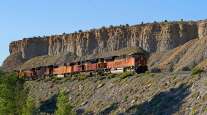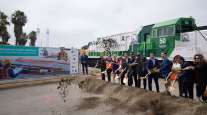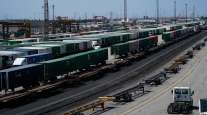Railroad 1Q Profits Increase on Rebound in Coal Shipping

This story appears in the May 1 print edition of Transport Topics.
All publicly traded freight railroads reported higher profits in the first quarter, led by a strong rebound in coal transportation from the doldrums of recent years and continued improvement in the intermodal sector.
The second week of earnings reports was an improvement on the first, when CSX’s profits rose 1.7% but Canadian Pacific’s plunged 20%. However, CSX and CP reported better intermodal results than last year. In fact, all the railroads except one posted an improvement in top-line intermodal results, another sign that the sector could have hit a low point and is heading in a positive direction.
• Kansas City Southern’s profits rose 36% in the first quarter to $146.5 million, or $1.38 per share. But after adjustments were made based on the foreign exchange rate, the total dropped to $124.1 million or $1.17. The adjusted results still beat the $1.16 consensus forecast of analysts surveyed by Bloomberg News.
One year ago, the company generated $111.3 million in profits, or $1.03 after adjustments for the peso.
Because Kansas City Southern operates in Mexico, some customers will pay in pesos, and the value of those proceeds must be converted into U.S. dollars because the shares are traded on the New York Stock Exchange.
Revenue increased 8.3% to $609.5 million.
Volume and revenue increased for energy products such as coal, coke, frac sand and crude oil. For example, coal revenue for utilities surged 88% to $42.8 million and volume 40% to 44,500 carloads.
However, intermodal volumes fell 1% to 224,000, and revenue dropped 2% to $83.5 million versus 2016 levels.
Kansas City Southern’s operating ratio was 65.4%, improving 120 basis points from the prior year.
• Norfolk Southern announced that profits increased 12% to $433 million, or $1.48, easily besting the $1.36 Bloomberg News average forecast.
One year ago, the numbers were $387 million, or $1.29. Revenue from railway operations rose 6% to $2.58 billion.
Intermodal revenue was up 9% to $571 million in the first quarter, and volumes grew 4% to 969,400 carloads. Coal revenue jumped 20% to $420 million during the period, and volumes increased 21% to 259,600. Revenue from transporting metals and construction materials went up 13% to $340 million.
Norfolk Southern’s operating ratio improved 10 basis points to 70% versus the first quarter of 2016.
• Union Pacific’s profits increased 9.5% to $1.07 billion dollars, or $1.32, after strong results in coal and agricultural transportation. The first-quarter results beat the $1.23 consensus forecast.
One year ago, Union Pacific generated $979 million in profits or $1.16.
Revenue from freight grew 6% to $4.79 billion.
Coal revenue grew 25% versus 2016 levels to $648 million. Volume improved 16% to 304,000 carloads.
Revenue from agricultural products rose 6.8% to $942 million, and volumes increased 6.4% to 250,000 carloads.
Intermodal revenue climbed 3.3% to $908 million and, although volume was flat year-over-year, Union Pacific earned more money per carload.
The company’s operating ratio was unchanged year-over-year at 65.1%, which Union Pacific blamed on a 40% jump in the price of diesel.
• Canadian National profits improved 12% to C$884 million, or C$1.16 per share.
Revenue grew 8.2% to $3.2 billion.
Intermodal revenue increased 7% to $742 million, and carload volume rose 9% to 568,000.
Coal revenue jumped 39% to $129 million.
Grain and fertilizers, and metals and mineral revenues increased 16% to a combined $968 million.
Metal and mineral experienced the greatest volume increase, 30%, to 232,000 carloads.
Canadian National’s operating ratio deteriorated 50 basis points but remained at a relatively healthy 59.4%.




